作者:Four Pillars
编译:深潮TechFlow
本文仅供一般信息使用,不构成法律、商业、投资或税务建议。请勿将其作为作出任何投资决策的依据,也不应依赖于此进行会计、法律或税务指导。提及特定资产或证券仅为说明目的,并不代表推荐或认可。本文中表达的观点仅代表作者个人观点,并不一定反映任何相关机构、组织或个人的看法。此处所反映的观点可能会未经更新而变化。
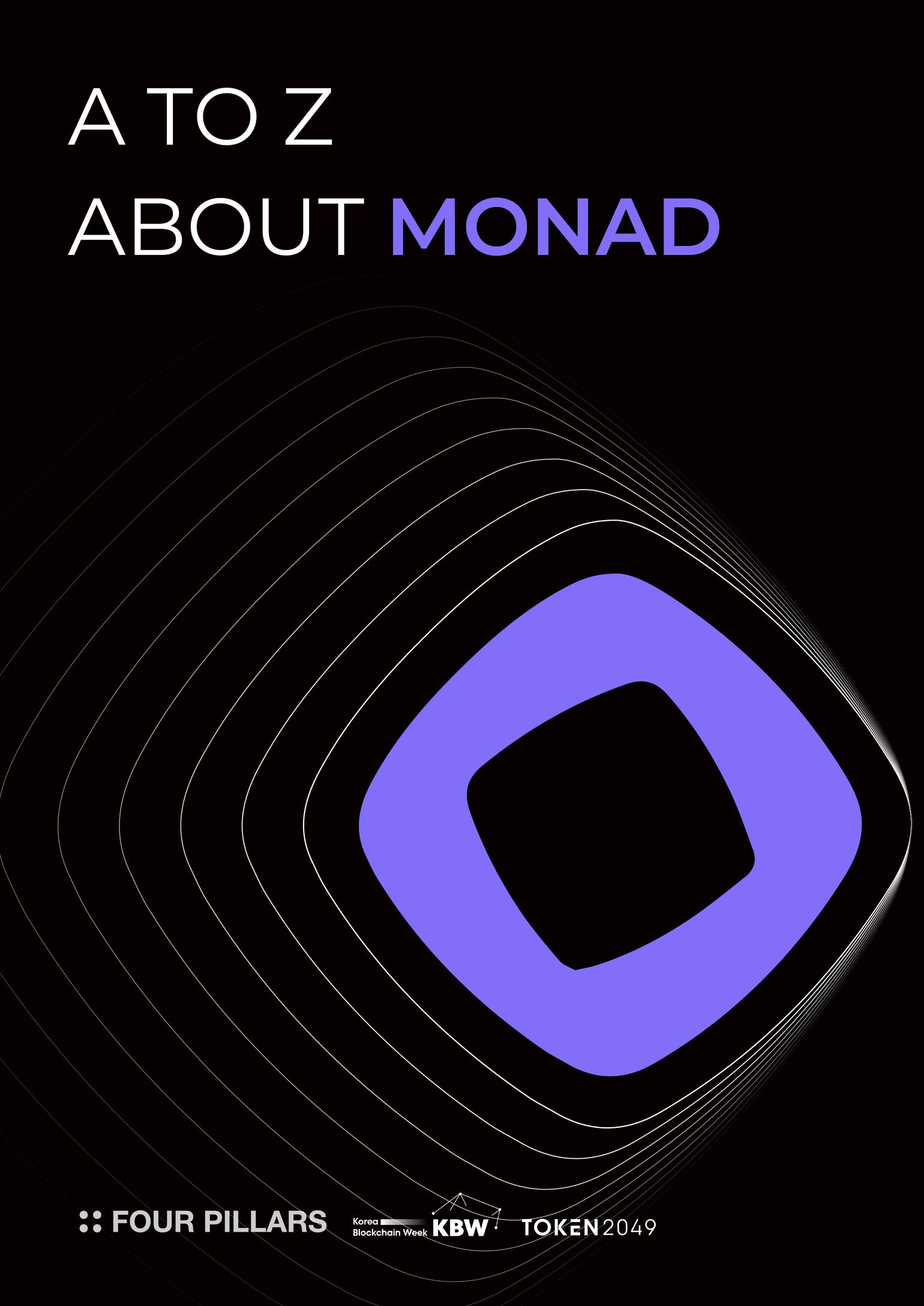
Four Pillars 为参加韩国区块链周(亚洲最大的区块链会议)和 Token 2049 的 Monad 区块链相关人士或 Monad 社区成员准备了一份全面的报告。
该报告涵盖了 Monad 区块链的起源背景、基础设施技术、社区及其在主网启动之前快速扩展的生态系统。其目标是增强对 Monad 区块链的理解,尤其是对那些可能不太熟悉它的人。
1. 再谈 EVM?但这次不一样
上一个市场周期的特点是众多链试图加速 EVM 的扩展。将这一时期描述为各种 EVM 兼容链的快速扩展并非夸张。除了以太坊及其上构建的众多 Rollup 项目外,Polygon (Matic)、Avalanche C-Chain (AVAX)、NEAR AURORA (NEAR) 和 Binance Smart Chain (BSC) 等项目也纷纷涌现,以提供更快的 EVM 执行环境,其增长尤为显著。因此,在当前市场周期中,“以太坊扩展解决方案”的叙述显得有些陈旧,难以引起市场的显著关注。尽管如此,Monad 区块链重新引入了“可扩展 EVM”的概念,出乎意料地在市场上获得了相当大的关注。这是为什么呢?
1.1 EVM 兼容,但像 Solana
“Monad 的价值主张十分简单。EVM 目前的性能仍然不够优秀,大家都希望获得更高的性能、更快的交易速度和更低的交易成本。” —— Keone Hon,Monad Labs 的联合创始人兼首席执行官。
我之前提到的“稍快的 EVM 兼容链”确实比以太坊更快,并且交易成本相对较低。然而,与 Solana(上一周期中脱颖而出的非 EVM 区块链,被视为以太坊的可行替代品) 相比,它们在多个方面仍显得不足。在速度方面,Solana 是最快的区块链,且提供了最低的交易成本。这使得上一周期的“快速 EVM 兼容链”处于一个相对平庸的境地。尽管它们比以太坊更快,但 Solana 通常被视为构建交易优化应用程序的最佳基础设施。因此,市场上仍然存在需求,希望有一种能够匹配 Solana 速度的区块链,同时利用现有的 EVM 开发者社区。
Monad 区块链旨在通过其技术填补这一空白,成为“能够在 EVM 内进行并行处理的高性能区块链”。在某种程度上,Monad Labs 推广了区块链领域的 EVM 并行处理概念。如果 Monad 区块链能够实现其目标指标(10,000 TPS 和 1 个区块确认时间),它可能成为第一条将 Solana 类似速度与完整 EVM 兼容性结合的区块链。
1.2 更高级的优化
仅仅将共识机制替换为更快的机制,然后在其上运行 EVM,存在一些技术限制(这一直是大多数 EVM 兼容 Layer 1 链所采用的方法)。要真正实现快速且可扩展的 EVM,不仅需要在共识层进行优化,还需要在所有层面——共识、执行和存储——进行优化(关于这些方面的详细讨论将在后面的技术部分中进行)。换句话说,仅在具有快速区块时间和高 TPS 的区块链基础设施上实现 EVM 并不足够。例如,Ethermint 在 Tendermint 上实现 EVM 执行环境时面临重大挑战,因为它无法在 EVM 环境中充分利用 Tendermint 的速度。这突显了更全面解决方案的必要性。
因此,Monad 区块链的目标不仅限于加速共识机制。它寻求从根本上改变执行环境,引入并行处理,并改进数据存储方法,以构建真正快速的 EVM 链。有关 Monad 区块链技术的详细解释将在后面提供。
1.3 社区驱动的生态系统
“加密社区总体上是非常了不起的,因为有很多人在事情还不完美之前就关心它们。” —— Keone Hon,Monad Labs 的联合创始人兼首席执行官。
最后,让我们谈谈社区。仅支持 EVM 并不足以吸引开发者加入 Monad 生态系统。因此,Monad Labs 专注于创建一个独特且有吸引力的社区,为开发者构建一个充满吸引力的生态系统。虽然我稍后会深入探讨这一点,但值得强调的是,Monad 区块链在启动主网之前就已经建立了一个强大的社区,这是一个高度战略的举措。最终,Layer 1 区块链需要吸引开发者,而开发者又需要用户支持他们的应用。由于大多数用户来自社区,因此,一个区块链拥有的忠实社区成员越多,吸引优秀开发者就越容易。在某种程度上,Monad 区块链为吸引熟练的服务提供者奠定了坚实的用户基础。这种方法在区块链领域尤其有效,Monad 执行这一策略的能力证明了团队的卓越实力。我稍后会提供更多关于 Monad 如何建立强大社区的细节。
仅从这三个特征来看,显然 Monad 区块链与众不同。我相信这些原因解释了市场对 Monad 区块链的高期望。那么,Monad Labs 背后的人是谁,他们的经历又是什么呢?
2. Monad Labs:与愿景保持一致的团队
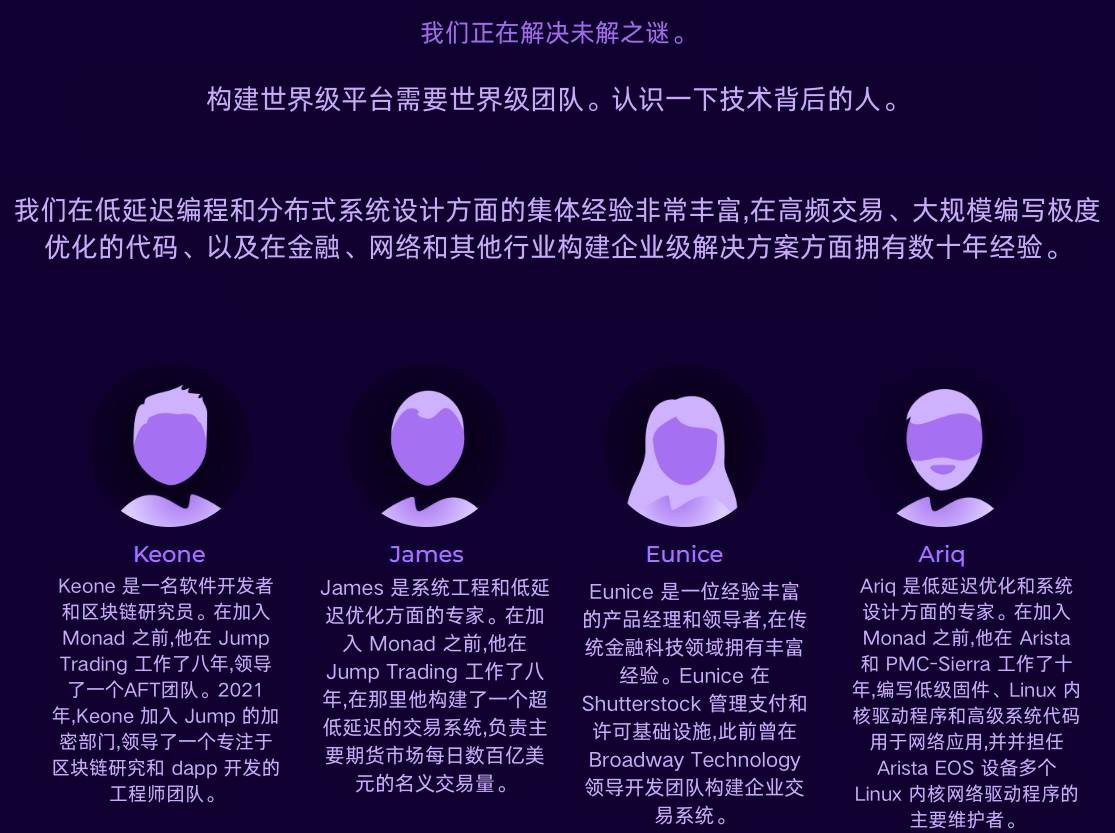
来源:Monad Labs
“在 Jump(Keone 之前的公司),一切都与表现有关。无论是系统方面,还是所有交易团队的每个人都需要非常高效,尽力而为。这是我在 Jump 学到的东西。” —— Keone Hon, Monad Labs 的联合创始人兼首席执行官。
在 Monad Labs 的团队中,有不少成员曾在 Jump Trading 工作。首席执行官 Keone 和首席技术官 James 都有 Jump Trading 的背景,还有其他几位工程师。特别有趣的是,Monad Labs 的许多开发者在为交易公司构建和优化系统方面有着丰富的经验。这一背景充分体现了 Monad 区块链的特性。Monad Labs 的目标是创建一个“高效且快速的 EVM 区块链”。此外,由于他们的目标是优化区块链以处理复杂的金融交易,因此团队中包含来自交易公司的工程师是非常合理的,他们在“优化、高效和系统改进”方面具有很高的技能。
当然,重要的并不仅仅是工程师。Monad Labs 同样重视建立强大的社区,与创造更高效的 EVM 环境同等重要。因此,Monad Labs 成功建立了与 Berachain 并列的最热情的区块链社区之一。在我看来,Bill 这样的团队成员是这一成就的关键贡献者,他在 Monad Labs 担任“文化领袖”的独特职务,以及 Kevin McCordic,Twitter Intern 账户的创始人。这些人对 web3 文化有着深刻的理解——Bill 在成功管理众多 NFT 项目方面有着良好的记录,而 Kevin 则因推广实习生账户这一趋势而备受推崇,如今许多 Web3 公司都在效仿这一做法。他们不断创作社区成员在 Twitter 和其他平台上喜爱的内容。
虽然有人可能会认为 Monad 区块链的社区主要是通过空投建立的,但这并不完全准确(我稍后会详细说明)。空投是任何项目都可以做的事情。使 Monad 社区脱颖而出的,是其作为社区所提供的内在价值,而这一点的核心正是 Bill 和 Kevin。
在支撑 Monad 的各种价值中,最重要的无疑是技术和社区。从团队组成来看,他们显然组建了一个最佳团队,以实现这两个核心价值。(由于本报告专注于 Monad 的技术和社区,我鼓励您继续阅读以深入了解。)
3. 深入探讨 Monad 区块链的技术
让我们深入探讨 Monad 区块链的核心价值之一:技术。Monad 区块链的技术可以分为三个主要组成部分:共识、执行和存储。在本节中,我们将详细了解 Monad 在这些领域所做的创新。
3.1 Monad 区块链的共识 - Monad BFT
Monad 的快速扩展能力源于其共识机制。Monad BFT 类似于 Aptos BFT 和 Diem BFT,是传统拜占庭容错(BFT)系统的进化版本。接下来,我们将探讨 Monad BFT 的具体特征。
3.1.1 Monad BFT 的过程
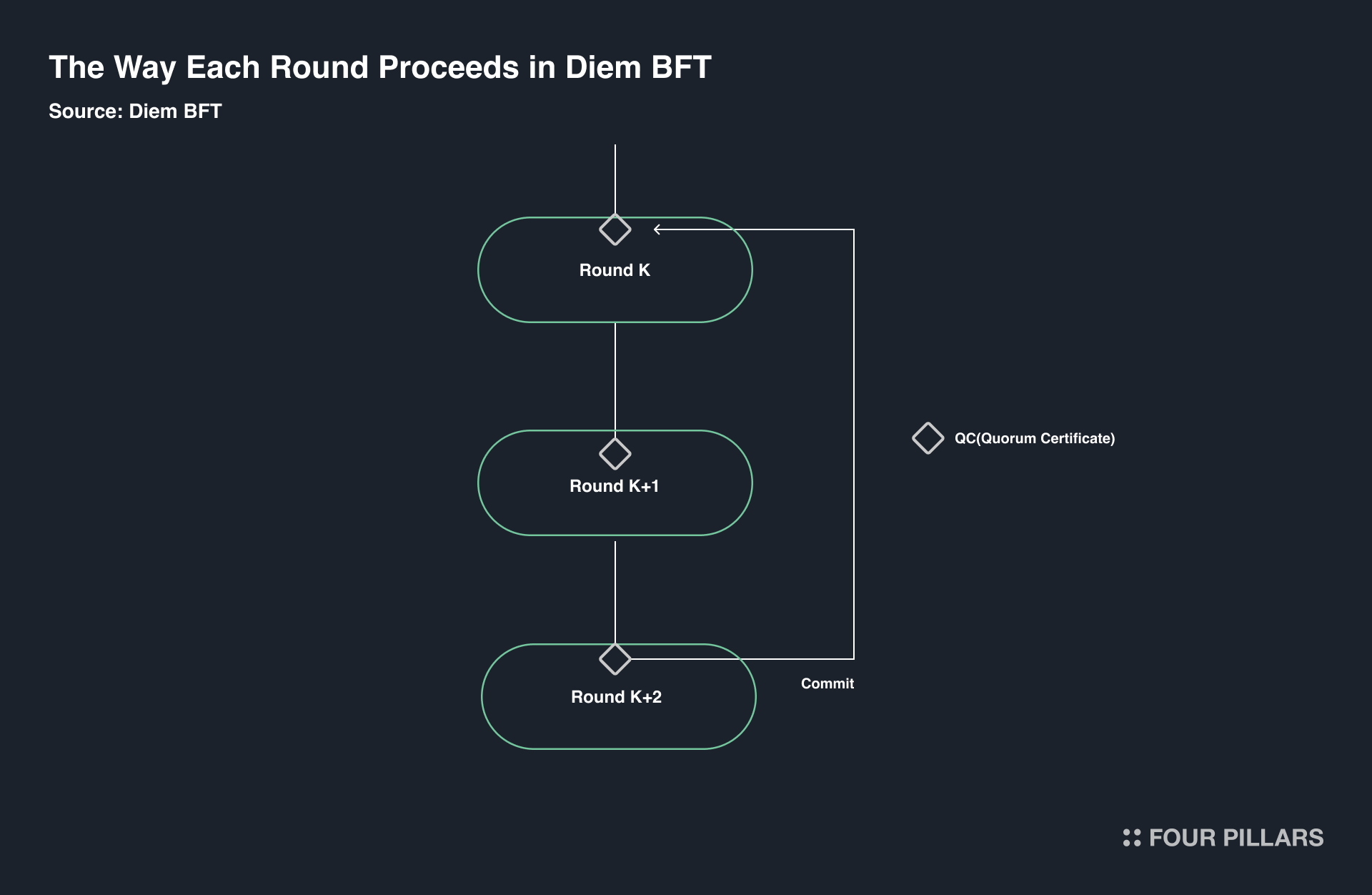
要理解 Monad BFT 的特性,首先需要了解系统内是如何达成共识的。为此,我们先定义几个关键术语:
-
法定人数证书 (QC):当网络中三分之二的节点验证上一个区块的正确性时,发出的证书。
-
超时证书 (TC):当网络中三分之二的节点未能验证上一个区块的正确性时发出的证书(通常是在预期时间内未收到有效区块提议时)。
-
为了简化,我们将初始轮次称为 K 轮,后续轮次称为 K+1、K+2,依此类推。K 轮的 QC 称为 QC(K),后续轮次的 QC 称为 QC(K+1)、QC(K+2) 等。初始轮次之前的上一轮的 QC 或 TC 分别表示为 QC(K-1) 或 TC(K-1)。
Monad BFT 的运作方式如下:
-
每轮的领导:每一轮都有一个领导者,负责推动这一轮的进程。领导者是预先确定的,并定期分配给每一轮。
-
每轮的两个阶段:
1. 提议阶段:领导者向验证者提议一个区块。
2. 投票阶段:验证者对提议进行投票,并将他们的投票发送给下一轮的领导者。
-
如果一切顺利,消息在没有网络问题的情况下传输,过程遵循线性通信模式,消息从一个(领导者)流向多个(验证者),然后再回到一个(下一轮的领导者)。然而,如果验证者未能及时收到领导者的提议,他们需要相互通信,导致二次通信模式的产生,在这之前需要验证者之间的交叉验证。
-
区块提议包括新区块和上一轮的投票信息,这也是为什么 Monad BFT 被称为“流水线”机制(稍后会详细讨论)。
-
-
处理提议:
-
如果验证者收到有效的提议,他们会向下一轮的领导者发送 YES 投票。如果三分之二的投票为 YES,下一轮的领导者将为上一轮的提议发出 QC。
-
如果验证者收到无效的提议或根本没有提议,他们会生成一个超时消息,并将其广播给所有其他验证者。如果任何验证者收到三分之二的超时消息,他们会创建一个 TC 并发送给下一轮的领导者。TC 还包括验证者观察到的最新 QC 信息。
-
-
发出新提议:
-
K+1 轮的领导者将根据上一轮的结果发出 QC 或接收 TC。然后,他们将创建一个新提议,包括(1)新区块的交易,(2)最新的 QC(如果上一轮成功则来自上一轮,或在超时情况下来自最近成功的轮次),以及(3)如果上一轮因超时而结束,则包括 TC。
-
-
最终确认区块:
-
验证者将在 K+2 轮中接收到 K+1 轮的 QC 后,才会最终确认 K 轮的提议。让我们分解一下:
-
持有 K 轮的 QC 意味着至少有三分之二的验证者在该轮中投了 YES。
-
然而,仅仅持有 QC 并不足以最终确认区块,因为验证者无法确认其他验证者是否也持有相同的结果。因此,还不安全执行交易。
-
这就是为什么验证者必须等到 K+2 轮,以确保 K+1 轮中的法定人数验证者发出了 QC,这确认了 K 轮的区块确实已最终确认。只有这样,验证者才能确信该区块已被大多数验证者验证,可以安全执行。
-
-
3.1.2 Monad BFT 与 HotStuff 的区别
如前所述,Monad BFT 将共识过程分为多个轮次,每轮由两个阶段组成。在第一阶段,领导者向验证者发送提议,在第二阶段,验证者将签名的响应发送回领导者以最终确认共识。Monad BFT 和 HotStuff 的显著区别在于涉及的阶段数量。HotStuff 通常需要三个阶段,这会在共识过程中引入额外的延迟。而 Monad BFT 将其减少到两个阶段。Monad BFT 能够做到这一点,因为在网络出现问题的情况下(如未能及时收到领导者的提议),验证者可以直接相互通信,以跳过问题轮次。
线性通信 vs. 二次通信
在二次通信模式中,领导者向节点广播提议后,每个节点必须将其投票数据广播给所有其他节点,这导致网络成本与 n² 成正比(其中 n 是节点数量)。这包括领导者的广播(n)和每个节点向其他所有节点广播投票(n)。相比之下,在线性通信模式中,节点只需将其投票传输给下一轮的领导者,从而将网络成本降低到大约 n(由领导者向 n 个节点广播,且每个节点的投票仅传输给一个节点)。这种线性通信的改进提高了区块链的吞吐量并减少了延迟。
如果网络运行良好,Monad BFT 依赖于线性通信。如前所述,这种方法不允许验证者在单轮内交叉验证领导者的完整性。因此,K 轮中的区块最终确认是在 K+2 轮中完成的。
3.1.3 流水线(Pipelining)
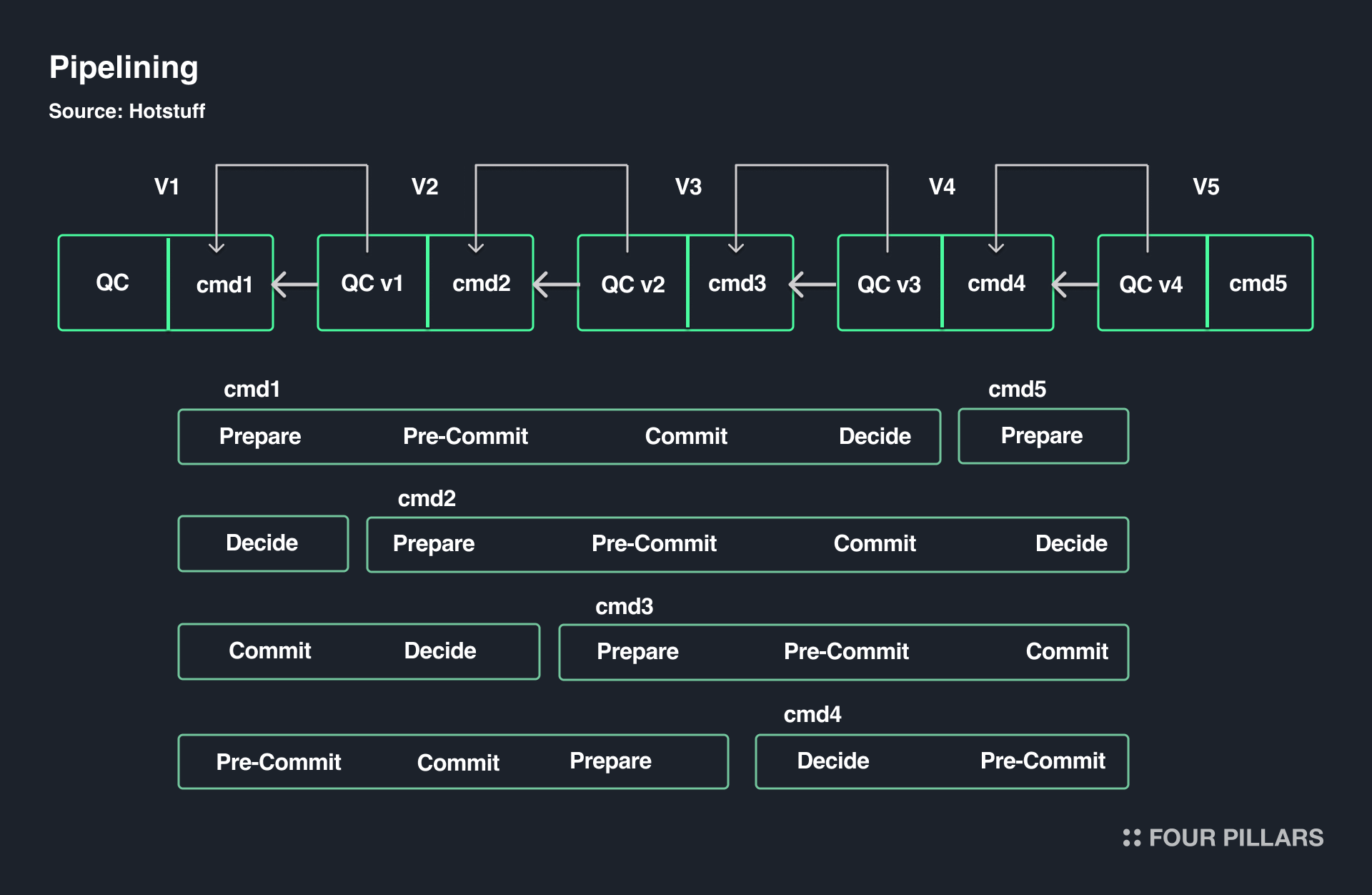
简单来说,流水线是将整个共识过程拆分,使其在多个轮次中进行处理,而不是仅在单一轮次中完成。例如,假设有一个区块 N,接下来是区块 N+1。即使法定人数已对领导者发送的消息进行投票,并为区块 N 生成了法定人数证书(QC),这并不意味着该证书必须在区块 N 中最终确认——它可以被转移(搭便车)到区块 N+1 中。
Monad BFT 的过程和方法与 Diem BFT 看似相似,但 Monad BFT 有一些独特的关键组件——共享内存池、延迟执行、运输费用和储备余额。
3.1.4 执行与共识的分离 - 延迟执行
Monad 区块链的一大特色是将交易执行与共识过程分开,这样可以提高共识的效率。正如我们在模块化区块链设计中了解到的,执行和共识是两个不同的概念。共识涉及如何将交易纳入区块,而执行则是实际处理这些交易以改变状态。在 Monad 区块链中,参与共识的领导者和验证者对提议进行投票,但并不执行交易。
那么,为什么 Monad 区块链要将执行与共识分开呢?我们先来看以太坊。在以太坊中,执行是在共识之前进行的。这意味着,在以太坊的共识过程中,验证者必须 1)就区块中的交易达成一致,2)就执行这些交易后生成的默克尔根(Merkle Root)达成一致。这要求领导者在分享提议之前执行所有交易,而验证者也必须在投票之前执行交易。这会造成显著的开销,因为 gas 限制必须谨慎估算,导致共识时间非常紧迫。
Monad 区块链通过将执行与共识分开来解决这个问题:当节点在 K 区块中执行交易时,它们可以同时参与 K+1 区块的共识。这种设计允许执行跟随共识,使区块链能够在合理的 gas 预算内运行。这种分离的前提是,一旦大多数节点达成交易顺序的共识,结果就已确定。
然而,分离执行和共识也引发了一个问题:“如果在不更新状态的情况下对交易进行排序(因为执行跟随共识),是否可能在没有 gas 费用的情况下包含用户的交易,从而导致潜在的拒绝服务攻击(DDOS)?”为了解决这个问题,Monad 区块链引入了运输费用的概念。
3.1.5 运输费用和储备余额
运输费用是指与交易相关的“交易费用”。由于 Monad 区块链将执行与共识分开,因此其交易费用结构也具有独特性。通常情况下,交易费用是在交易执行时支付的,但在 Monad 区块链中,执行费用和运输费用是分开的。如果一笔交易具备必要的运输费用但缺少所需的执行费用,则该交易将会失败。这种设计防止了用户在资金不足的情况下反复尝试发送交易。
此外,节点为每个账户创建一个储备余额(Reserve Balance),这是一个专门用于运输费用的单独余额。储备余额的目的是确保只有支付了必要费用的交易才能被纳入区块中。
3.2 Monad 区块链的执行 - 并行执行
在了解 Monad 区块链的共识机制后,我们接下来探讨 Monad 区块链是如何处理交易的。Monad 区块链在行业中获得的关注,以及如今定义它的关键词——并行交易处理,正是源于这一领域。那么,Monad 区块链是如何实现并行交易处理的呢?
3.2.1 并行交易处理
让我们考虑两个交易,分别称为:
-
交易 A:账户 A 从账户 B 收到 Monad 区块链代币。
-
交易 B:账户 A 将 Monad 区块链代币发送给账户 C。
如果这两个交易是并行处理的(即交易 B 在交易 A 完成之前开始),那么在这些并行交易后,账户 A 的余额可能与顺序处理这些交易时的余额不同。这可能导致交易执行错误。
为了解决这个问题,Monad 区块链采用了受软件事务内存 (STM) 和 Optimistic 并发控制 (OCC) 启发的方法。正如 OCC 这一术语所暗示的,Monad 区块链假设所有交易都是有效的,并继续执行,只有在验证过程中出现问题时才会重新执行交易。Monad 确保这些执行的结果与顺序处理交易时的结果相同,即使交易是并行处理的,其状态更新也是顺序合并的,以确保并行执行的有效性。换句话说,Monad 区块链首先处理交易,然后根据初始执行获得的信息重新处理任何有问题的交易,而不是事先验证交易之间的依赖关系。
这种方法比预验证交易依赖关系并相应地执行要高效得多。在乐观事务并行处理模型中,一旦一个区块中的所有先前交易都已处理,哪些交易需要重新执行就变得清晰。在此时,由于先前交易的状态值已被合并,因此重新执行交易时失败的风险很小(在这种情况下,交易不可能失败)。此外,像签名恢复这样的任务在重新执行时不需要重复,而在交易执行期间访问的账户或存储也不会改变,这使得这种方法非常高效。
3.3 Monad 区块链的存储 - Monad DB
实际上,执行层的并行处理并不是特别困难。它已经在多个区块链中实现,但最关键的是并行交易处理是否能高效进行。Monad 区块链注重性能,这意味着区块链中所有账户的信息快速增长。这些信息存储在区块链的状态中,随着状态大小的增加,可能导致性能下降,从而削弱并行交易处理的优势。因此,高效管理区块链状态在并行交易处理中至关重要。
为了解决这个问题,Monad 区块链开发了独特的数据库结构来高效管理状态——Monad DB。大多数以太坊客户端使用基于 B 树结构(如 LMDB)或 LSM 树结构(如 LevelDB 和 RocksDB)实现的键值数据库。然而,以太坊使用一种称为默克尔帕特里夏树(MPT)的数据结构来存储状态,这种方法效率较低,因为它在另一种数据结构(键值数据库)内使用了 MPT。Monad DB 通过在磁盘和内存中原生实现帕特里夏树结构来解决这个问题。
此外,Monad DB 支持异步 I/O,允许 CPU 同时处理多个交易,而无需等待交易的输入和输出。传统以太坊数据库不支持异步 I/O,而 Monad DB 的支持显著提高了交易处理效率。
除了这些功能,Monad DB 还通过绕过文件系统等优化来提升 I/O 过程,减少不必要的开销,从而提高数据库性能。这确保了不仅执行层得到优化,而且在数据库层面上也能实现高效的交易处理。
4. 不仅仅是技术,Monad 区块链的有趣社区建设方法
到目前为止,我们已经探讨了 Monad 区块链的技术,这被认为是其关键优势之一。但 Monad 区块链成功的另一个重要方面——其社区又如何呢?众所周知,Monad 区块链的快速增长得益于一个强大且成熟的社区。目前,Monad Discord 上大约有 380,000 名成员,这让我们对其社区的庞大规模有了初步的了解。此外,在 X 平台上,象征 Monad 社区的 memes 仍在积极分享,主要围绕 Monad Labs 成员和官方账号的帖子。那么,是什么驱动了人们对 Monad 区块链的热情呢?
首先,有一点是明确的:正如我之前提到的,空投并不是这个社区增长的主要原因。空投是任何人都可以使用的工具。如果 Monad 仅仅依靠空投来建立其社区,其他项目也能够创造出如此规模的社区。然而,Monad 区块链与 Berachain 一起,被认为是区块链领域中拥有最热情社区的项目之一。因此,在讨论 Monad 的社区策略时,简单地将其成功归因于空投是不准确的。
“质量 > 数量”。
“自动化任务并不是一个好的策略。在一些平台上,人们为了“关注、点赞、转发”而声称奖励,虽然这看似是一种低成本的提升参与度的方法,但它实际上稀释了那些会自然参与的真实用户。当你看到 7,200 个点赞、7,200 次转发和 10,000 次浏览时,这种情况显得相当糟糕。不要为了获取机器人的参与度而牺牲那些会在你社区中待几个月或几年的真实用户——你永远无法以这种方式创建可持续的循环。” —— Kevin McCordic,Monad Labs 的增长负责人。
当我们仔细观察 Monad 社区成员的互动,以及 Monad Labs 在社区建设中采用的策略时,很明显,认为 Monad 完全依赖空投来创建社区的观点是不太可能的。毫无疑问,除了单纯的经济激励之外,还有更重要的因素在团结这个社区。此外,Monad Labs 似乎并不将社区视为短期的营销活动来引起兴趣。那么,是什么驱动了 Monad 区块链强大的社区?又是什么样的思维过程和战略行动使 Monad 能够创造出如此有影响力的社区?让我们一步步来探索。
4.1 Nads 代表文化,EVM/ACC 代表愿景

Monad 社区的核心在于其充满活力的 meme 文化。任何熟悉加密 Twitter 的人都可能见过紫色的 Monanimals,这一 meme 起源于 Monad 社区,象征性地代表了他们的“教派”文化。这只是一个例子,社区成员自称为“Nads”,他们不断创造和重塑 memes、图像(例如 keonegg)和语言(例如 Gmonad),以表达 Monad 社区的身份。参与这些 memes 不仅在加强社区内部的联系方面发挥了关键作用,还提升了 Monad 社区在外部的知名度。
然而,Monad 区块链强大社区的增长是否仅仅归功于其 meme 文化?在我看来,这些 memes 更像是促进增长的催化剂,而不是根本原因。推动 Monad 社区快速发展和坚实基础的真正动力——通常被称为“一队”的理念——在于社区成员与 Monad Labs 之间的共同愿景:EVM/ACC。当 Nads 代表文化时,EVM/ACC 则体现了社区的本质。
Monad 区块链的技术愿景集中在扩展 EVM,目标是“10,000 TPS 和 1 个区块最终确认”。正是由于这个明确的目标,社区成员常常在他们的 X 个人资料中提到“EVM/ACC”,以此表明他们作为 Nads 的身份。EVM/ACC 是“e/acc”的变体,代表“有效性效率”(Effectiveness Efficiency)——一种倡导不受限制的技术进步的理念,尤其是在人工智能等领域。这与所谓的“decel”运动形成鲜明对比,后者主张由于潜在风险应减缓技术进步。
那么,EVM/ACC 具体意味着什么?它可以理解为“EVM 区块链的不受限制的技术进步”,这与 Monad 区块链克服 EVM 限制的使命完美契合。当一个社区与他们支持的项目分享相同的目标时,这便成为强大社区的基础。这种一致性使得社区成员能够成为支持项目成功的粉丝,而项目团队则可以将社区视为其成长的重要合作伙伴,从而鼓励积极参与。
我常常将区块链比作一个国家,考虑到一个国家如何运作,与 Monad Labs 如何建立和发展其社区是相似的。Monad Labs 设定了明确的技术目标——创建一个“能够进行 EVM 并行处理的高性能区块链”——那些与这一目标产生共鸣的人聚集在一起,形成了一个具有共同愿景的社区。从此,独特的社区活动,包括 memes,帮助吸引更多成员并维持现有社区。
正如前面提到的,空投是几乎每个项目都向其社区提供的隐性经济激励。基于 meme 的营销也已成为加密项目的标准方法。然而,使 Monad 区块链与众不同、能够建立如此独特成功社区的原因在于,该项目一开始就有一个明确而引人注目的目标,使人们能够真正与之产生共鸣并支持它。
4.2 系统方法论在社区建设中的应用
我本月与10多个S级加密项目进行了通话,讨论如何建立更强大的营销和社区飞轮 - 在这里公开分享一些建议。
加密营销和社区的10条规则:一种系统的方法
1. 停止发布广告。
如果你的主要推特账号不断谈论你的产品,那就是在发广告。人们讨厌广告。当你打开YouTube观看特定视频时,你迫不及待想跳过弹出的广告。加密推特也一样。如果你持续发布广告,当人们不喜欢你的品牌或不参与互动时,不要感到惊讶。
2. 你是在与推特上的影响者和娱乐内容竞争,而不是与其他协议竞争。
当大多数人打开加密推特时,他们是在查看Cobie发布了什么,或者关于ETH ETF创建了什么梗,或者那天的趋势是什么 - 他们享受的娱乐内容。你是在与这些人在同一注意力经济中竞争,而不仅仅是与你项目的竞争对手竞争。
3. 你的营销和社区策略应该采取系统方法。
将营销和社区视为一个具有各种输入和输出的复杂系统,而不是独立的分割区域,这种看法更准确。Discord、Telegram、Twitter等之间存在相互影响的流动。优化这些领域之间的良好流动将产生比单独处理每个领域更好的结果。社区和营销是交织在一起的。如果你将它们隔离,两者都会变得不那么有效。它们是一个组合 - 确保系统允许它们互相增强。

来源: X(@intern)
考虑到 Monad 社区内出现的强中心聚焦,显然,社区的持续增长和如今的社区形态是 Monad Labs 经过精心规划和战略设计的结果。正如之前在介绍 Monad Labs 成员时提到的,Kevin McCordic 是 Monad Labs 的增长负责人,也是加密项目中流行的 Intern 账号趋势的推动者,他通过自己的 X 账号分享了有关营销和社区策略的见解。他的观点揭示了社区和营销策略的核心原则,其中一个关键见解是系统化方法的重要性,这种方法建立了一个飞轮效应,使社区和营销相互关联、相辅相成。
这种飞轮方法确保了随着社区参与度的提升,营销工作也会得到推动,从而吸引更多的社区成员,形成一个自我维持的增长循环。最终的结果是,社区不仅在数量上增长,还在力量和凝聚力上增强,为项目的整体成功和持久性做出了贡献。
“你的营销和社区策略应该采取系统化的方法。更准确地说,应该通过复杂系统的视角来看待营销和社区,而不是将其视为一次性分隔的领域。Discord、Telegram、Twitter 等之间存在着相互影响的流动。优化这些领域之间的良好流动将比单独处理每个领域产生更好的结果。社区和营销是相互交织的。如果你将它们孤立分开,双方的效果都会降低。它们是一个团队——确保系统能够使它们相互增强。” —— Kevin McCordic,Monad Labs 的增长负责人

来源: X(@monad_xyz)
例如,最近 Monad 宣布了一项奖金池高达 100 万美元的项目竞赛,并有超过 60 家风险投资公司参与,这引起了广泛关注。对此,Intern 提议社区可以通过直播观看比赛并进行实时投票。这个想法演变成了一场关于创建预测市场的更广泛社区讨论,成员们可以对比赛结果进行投注。尽管竞赛最近才宣布,尚未有预测市场平台正式计划基于该事件开放市场,但这一情景展示了社区参与和营销之间的紧密关系,以及它们如何积极影响项目的增长。换句话说,这场项目竞赛——Monad 吸引生态系统建设者的增长活动以及展示对生态系统发展的承诺的营销策略——提供了能够吸引社区成员注意的内容。这些围绕内容产生的互动进一步推动了讨论和创意,最终为项目的营销工作和增长做出了贡献。
与传统行业中相对标准化的营销策略不同,加密项目中的社区和营销策略仍处于早期阶段,各种讨论和实验正在进行。Monad 社区的显著活动,加上团队卓越的增长策略,为未来的加密项目提供了宝贵的见解。这些见解强调了在开始建立社区之前,拥有明确目标和方向的重要性,而一旦建立了初步社区,采用考虑社区和营销之间相互作用的系统化方法则至关重要。这种方法可以带来可持续的增长和进一步的创新。
5. Monad 生态系统
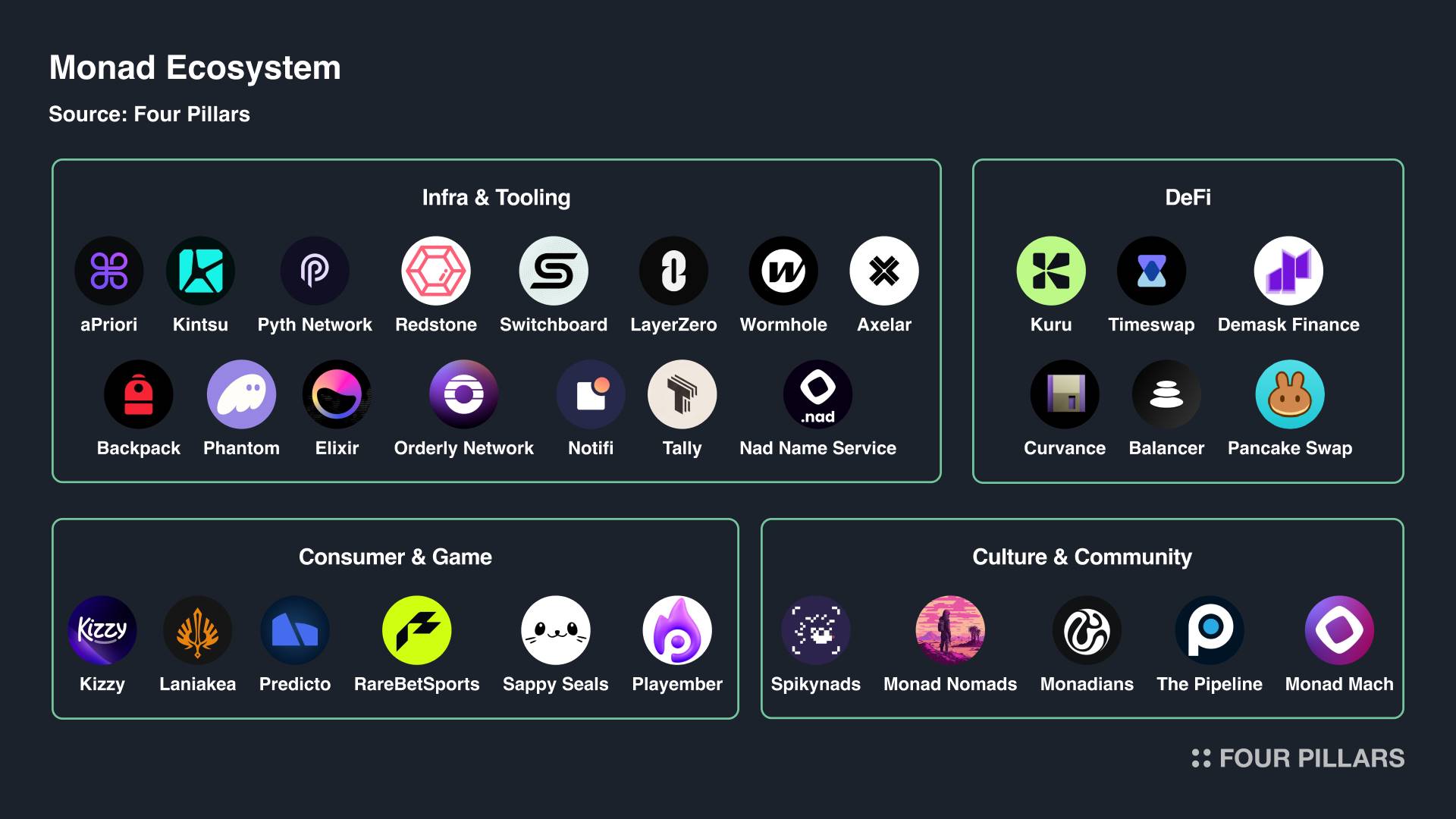
通过 Monad BFT、并行事务处理和 Monad DB 的结合,Monad 区块链在其基于 EVM 的网络中实现了显著的可扩展性。成熟的社区加上这些技术因素,为项目建设者创造了一个理想的创新和实验环境。可扩展的 EVM 环境允许实施高性能协议,同时为开发者、用户以及从其他基于 EVM 网络迁移的流动性保持最小摩擦。此外,强大的社区确保了新项目有现成的受众,使 Monad 成为一个极具吸引力的开发生态系统。
毫不奇怪,尽管尚未推出主网,Monad 生态系统仍在迅速扩展。已经证明有用的项目,如 Phantom Wallet、Wormhole 和 Balancer,正在加入 Monad 生态系统。同时,针对 Monad 区块链优化的新项目,如 Kuru、aPriori 和 Kintsu,也在不断涌现。还有许多其他项目也在准备在主网启动前在 Monad 生态系统中立足。接下来,我们将探索一些填补 Monad 生态系统空白的有趣应用和基础设施项目。
5.1 基础设施与工具
-
aPriori
aPriori 是一个针对 Monad BFT 优化的可提取矿工价值拍卖 (MEVA) 基础设施。Monad 区块链的区块生产机制采用延迟执行,将执行与共识分离。aPriori 正在设计与这一方法相适应的 MEV 基础设施,并最近获得了来自 Consensys、OKX Ventures 和其他机构的 1000 万美元种子资金,使其成为 Monad 生态系统中的关键参与者。
-
Kintsu
Kintsu 是一个流动性质押协议,类似于以太坊上的 Lido Finance,将参与 POS 网络验证的质押资产进行代币化。流动性质押代币 (LSTs) 在网络中提高资本效率方面发挥着至关重要的作用,尤其是在新 Layer 1(如 Monad 区块链)的冷启动阶段。Kintsu 最近筹集了 400 万美元的种子资金,并正在成为 Monad 生态系统中领先的流动性质押协议,具有与多种 DeFi 应用集成和扩展生态系统的潜力。
-
Pyth Network
Pyth Network 是一个预言机网络,为区块链上的 DeFi 协议提供实时第一方金融数据。Pyth 目前聚合了来自超过 111 个第一方数据提供商的数据,并向包括 Monad 区块链在内的 70 多个区块链网络提供加密资产、股票、ETF 和商品的实时价格数据。
-
Redstone
Redstone 是一个模块化预言机网络,提供实时价格数据,重点维护诸如 LSTs 和 LRTs 等带息代币的锚定。Redstone 支持包括 Monad 区块链在内的 50 多个区块链网络,并在确保准确可靠的数据馈送方面发挥着至关重要的作用。
-
Switchboard
Switchboard 是一个预言机聚合器,将 Pyth Network 和 Chainlink 等多个预言机集成到单一交易中。这使得应用程序能够高效地获取所需的数据馈送,并降低依赖单一预言机所带来的风险。
-
LayerZero
LayerZero 是一个协议,使用超轻节点、区块链端点、去中心化预言机和中继器实现区块链之间的直接通信。LayerZero 旨在建立一个全链网络,允许各种区块链可靠地通信和交换数据。
-
Wormhole
Wormhole 是由 Jump Crypto 于 2021 年推出的桥接协议,促进不同区块链之间的消息和资产转移,包括 Monad 区块链。Wormhole 旨在通过创建一个资产和信息可以在网络之间自由流动的集成环境,克服区块链生态系统中的流动性碎片化问题。
-
Axelar
与 Wormhole 类似,Axelar 是一个跨链网络,连接各种区块链并使它们能够相互作用。Axelar 旨在支持不仅是链间连接,还包括可以无缝实施跨多个链的跨链去中心化应用(dApps)的开发。
-
Backpack
Backpack 最初作为一个支持 EVM 网络和 Solana 的非托管钱包服务,后来发展成为一个涵盖 NFT 收藏(Mad Lads)、钱包(Backpack Wallet)和交易所(Backpack Exchange)的生态系统。Monad Labs 参与了 Backpack 的 A 轮融资,其交易平台和用户基础预计将与 Monad 区块链紧密集成。
-
Phantom
Phantom 是一个非托管钱包服务,最初支持 Solana,后来扩展其功能以创建用户友好的移动环境。Phantom 计划加入 Monad 生态系统,扩展其服务以实现链无关性。
-
Elixir
Elixir 是一个去中心化的做市协议,为多个网络上的订单簿去中心化交易所(DEXs)提供流动性。与支持订单簿的永续期货交易所集成,Elixir 最小化对中心化做市商的依赖,使零售用户能够参与流动性提供。考虑到 Monad 区块链的结构,支持快速高效的交易处理,要求高频交易的订单簿交易所可以从与 Monad 区块链的集成中获益良多。
-
Orderly Network
Orderly Network 是一个全链流动性层,整合了跨各种网络的共享订单簿,以增强永续期货 DEXs 的流动性。像 Monad 区块链这样的新网络通常难以确保稳定的永续交易流动性,但 Orderly Network 旨在通过提供共享订单簿来解决这个问题,使交易者能够体验到无摩擦的交易,享受窄点差和最小滑点。
-
Notifi
Notifi 是一个基础设施,使 Web3 项目能够与用户进行链上通信,从简单消息到钱包间通信。Notifi 在增强用户体验方面发挥着重要作用,使任何应用程序都可以选择与最终用户通过通知或消息进行互动。
-
Tally
Tally 为进行链上治理的 Web3 项目提供 DAO 解决方案。Tally 提供插件用户界面和 DAO 治理合约,使用户能够对提案进行投票或委托投票权。Tally 预计将在支持 Monad 生态系统内各种项目的链上治理中发挥重要作用。
-
Nad Name Service
Nad Name Service 是一个类似于以太坊域名服务(ENS)的区块链域名服务。它允许用户在 Monad 区块链内拥有其独特的地址(域名)。就像 .com、.io 和 .xyz 等域名在互联网上的使用一样,Nad Name Service 使用 .nad 域名,使得实体可以通过域名地址进行交互,而无需记住整个地址。
5.2 去中心化金融 (DeFi)
-
Kuru
Kuru 是一个完全链上的去中心化交易所(DEX),提供中央限价订单簿(CLOB),最近成功筹集了 200 万美元的种子资金。大多数基于 EVM 的订单簿 DEX 通常在链下处理用户订单和交易匹配,然后再在链上完成交易,这是一种混合模式。然而,Kuru 的目标是实现一个完全链上的订单簿,所有订单和交易都在链上处理,充分利用 Monad 区块链的快速区块时间和低延迟优势。
-
Timeswap
Timeswap 是 Monad 生态系统中的一个无预言机借贷协议。大多数借贷协议依赖于预言机提供的价格数据来管理借款人的抵押品比率,并在抵押品未达到特定阈值时进行清算。与此不同,Timeswap 在点对点的基础上匹配借款人和贷款人,贷款的到期日由双方协商确定。如果借款人在到期日前未能偿还贷款,其抵押品将被没收。这种机制消除了对预言机的需求,使 Timeswap 能够为任何基于 ERC-20 的资产创建货币市场,包括流动性较低的长尾资产。
-
Demask Finance
Demask Finance 是一个自动做市商(AMM)协议,旨在促进 NFT 和 ERC-20 代币之间的交易,帮助流动化 NFT 资产。Demask 目前与 Monad 生态系统中的一些关键 NFT 收藏品(如 SpikyNads 和 Monad Nomads)建立了合作关系,预计在主网启动后将对扩展 Monad 的 NFT 生态系统发挥重要作用。
-
Curvance
Curvance 整合了 Curve、Aura 和 Convex 等多个 DeFi 协议,提供一个统一的界面,优化流动性管理。用户可以通过 Curvance 在集成的多链环境中将代币作为抵押品存入或借贷,成为连接包括 Monad 区块链在内的基于 EVM 网络的 DeFi 流动性的重要工具。
-
Balancer
Balancer 是一个可扩展的 AMM,提供多种流动性池和交易服务,从集中流动性池到稳定交易和自定义流动性池。作为一个与 Uniswap 和 Curve 一起发展了很长时间的 OG 项目,Balancer 预计将在 Monad 区块链的新兴 DeFi 生态系统中提供稳定的交易支持。
-
Pancake Swap
Pancake Swap 是一个领先的 AMM DEX,最初在 BNB 网络内发展。最近,Pancake Swap 推出了 Pancake Swap v4,增加了新功能,如 Hook,允许开发者自定义流动性池并优化 gas 使用。Pancake Swap 正在积极准备加入 Monad 生态系统。
5.3 消费者与游戏
-
Kizzy
Kizzy 是一款即将在 Monad 生态系统中推出的全新消费者应用,提供移动社交媒体博彩服务。尽管尚未公开发布,但它已经引起了广泛关注,首席执行官 Keone Hon 等关键人物对此进行了积极的宣传。
-
Laniakea
Laniakea 是一款开放世界的 MMORPG 游戏,提供多种游戏模式,包括实时战斗、玩家对战 (PvP) 和玩家对环境 (PvE) 的挑战。由于游戏需要高频交易,类似于永续期货交易所,Monad 区块链的网络性能预计将为实现这些游戏服务提供强有力的支持。
-
Predicto
Predicto 是 Monad 生态系统中即将推出的预测市场平台。随着对 2025 年美国总统选举预测市场的兴趣不断增加,以及 Polymarket 等平台的崛起,预测市场正在成为下一个重要的应用领域。Predicto 有望成为 Monad 的主要预测市场,结合 Monad 区块链活跃的社区,预计它将蓬勃发展。
-
RareBetSports
RareBetSports 是一款 Web3 体育应用,旨在彻底改变每日幻想体育 (DPS) 的游戏体验,用户可以创建自己的团队参加虚拟体育赛事。这款应用在 Monad 生态系统中备受期待,关键人物如 Keone Hon 对其寄予厚望。
-
Sappy Seals x Playember
Sappy Seals 最初是一个 NFT 收藏品,现在正与游戏工作室 Playember 合作,在 Monad 生态系统内推出一款基于其知识产权的游戏。
5.4 文化与社区
-
Spikynads、Monad Nomads 和 Monadians
Spikynads、Monad Nomads 和 Monadians 是 Monad 生态系统中的社区驱动 NFT 收藏品。这些团体自 2023 年测试网启动以来便是 Monad 社区的一部分,预计将在主网启动后对 NFT 生态系统发挥重要作用。
-
The Pipeline
The Pipeline 是一个媒体团队,专门负责传递 Monad 生态系统的新信息和更新。他们制作了播客,邀请 Monad Labs 的关键成员(如 Keone 和 Kevin McCordic)参与,并为 Monad 社区提供重要的内容支持。
-
Monad Mach
Monad Mach 是一个加速器项目,旨在支持 Monad 生态系统内的项目建设者。MACH 1 计划预计将在 2024 年第四季度启动,将为开发 Monad 生态系统内项目的建设者提供指导、资助和筹款支持。此外,项目还将提供为期四周的课程,涵盖开发、设计和市场营销等领域的内容。
这些项目和举措展示了 Monad 生态系统的快速和动态扩展,继续吸引多样化的应用和基础设施。在坚实的技术基础和活跃的社区支持下,Monad 区块链在推动区块链领域的创新和增长方面具有良好前景。
6. Monad 的未来
我们已经探讨了 Monad(包括区块链和实验室)的各个方面,令我印象深刻的是,尽管尚未推出主网,该项目已经取得了显著的成就。Monad 建立了一个比许多已经推出主网和代币的项目更为稳固的社区。在技术上,Monad 区块链正在突破其他 EVM 链所不敢尝试的界限。如前所述,Monad 区块链为建立和维持其社区所采用的策略是如此卓越,以至于可以成为区块链领域众多其他项目的标杆。从整体上看,区块链技术表明,技术和社区都是至关重要的,而 Monad 区块链在这两个领域都表现出色。这表明 Monad Labs 的团队对区块链和 Web3 的动态有深刻的理解,使 Monad 的未来更加光明。
Monad 区块链能否克服 EVM 的局限性?它能否维持并进一步发展其已建立的强大社区?虽然无法确定地预测未来,但根据 Monad 区块链迄今为止的表现,我预计它将作为一条 Layer 1 区块链开辟新天地,在行业中树立新的标准。
作为一名支持单体区块链(深潮注:单体区块链即所有交易和数据处理集中在一个区块链上)并倡导单分片优化的人,我对 Monad 区块链的未来充满期待,并将密切关注它的发展历程。
免责声明:本文章仅代表作者个人观点,不代表本平台的立场和观点。本文章仅供信息分享,不构成对任何人的任何投资建议。用户与作者之间的任何争议,与本平台无关。如网页中刊载的文章或图片涉及侵权,请提供相关的权利证明和身份证明发送邮件到support@aicoin.com,本平台相关工作人员将会进行核查。




